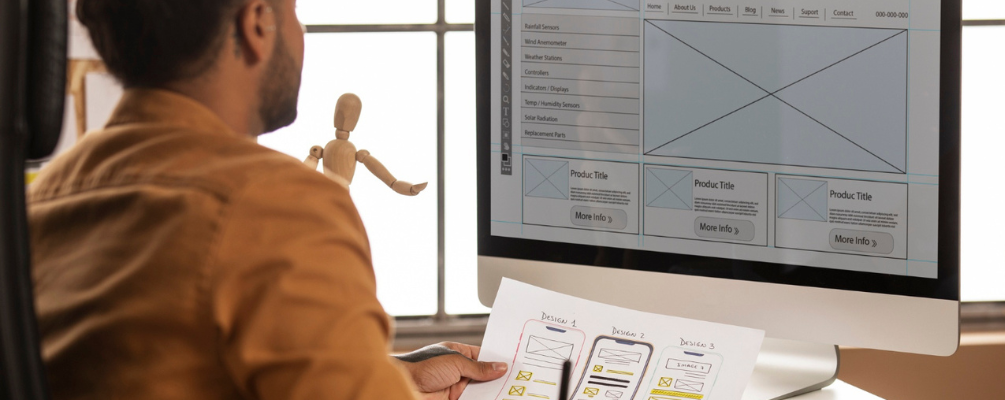> Articles > Why is Wireframing Essential for Successful Product Design?

Why is Wireframing Essential for Successful Product Design?
Before spending a significant amount of valuable time, money, and effort, artists tend to get a preview of the finished result beforehand. Wireframing provides the same thing during the overall product UI/UX design process.
You can see your ideas come to life and test design concepts with a few sketches before committing to them fully. This allows you to incorporate everything you want into the finished design. In this post, we’ll read the advantages of using wireframing and why it is necessary to create a successful design.
What is Wireframing?
At its core, wireframes are black-and-white drawings that indicate where buttons, text, and pictures should be placed. They may be made with a variety of instruments, such as computerized wireframing tools or a pencil and paper.
Wireframes are a useful tool for getting feedback and iterating designs since they are usually used to confirm design concepts and test user interactions. They can be quickly assembled and adjusted as necessary to do user testing, making them ideal for this process.
During the wireframing phase, user testing concentrates on the layout, user interface components, and aesthetic factors like colors and fonts. The main target audience should be the test users. Team members can get advice and feedback on improving the final design based on the product wireframing phase.

Importance of Wireframing in Product Design
Given that wireframes are an essential part of the product design process, their significance cannot be overstated. A product might have many different looks, but you need to choose the one that will best support your company’s objectives. Wireframing can help:
● Reduce the gap between abstract ideas and their representation in the solid form
● Make sure every page element has a proper purpose
● Clarify several unknowns and formulate final requirements
● Allow communication of design ideas at the basic level
● Determine must-include content, functionality, and their interactions
● Align page structure and hierarchy information
● Help designers experiment with concepts, templates, layouts, interactions, etc.
Advantages of Using Wireframing in Product Design
If you work on UI/UX design or aspire to become a designer, here are some wireframing advantages you should know.
Easy & Quick Visualization of Layout and Functionality
Before settling on a final design, designers can quickly experiment with various layouts and features using wireframes. Long term, this can save a substantial amount of time and resources. This is especially useful early on in the design process when you and your team are still coming up with ideas and possibilities.
Your wireframe production time can decrease by using pre-made user interface packs, which include components like navigation bars, dropdowns, forms, sliders, etc.
Allows Quick Iterations & Testing
Regular communication with the team throughout wireframing allows for prompt implementation of recommended modifications, thereby saving time and effort.
Getting regular feedback also helps you and your team members grasp the objectives and specifications of the project more thoroughly, which keeps everyone on the same page. Keeping track of your wireframe revision history is a smart idea if you often switch between iterations, which can help transform the final product design.
Improves Collaboration & Feedback
As wireframes are simplified versions of the final product design, they allow better teamwork and communication, enabling successful and productive feedback loops throughout the design process. Designers and stakeholders can collaborate to decide on the overall design by using wireframes.
This cooperation can lead to a better final product that fits the demands of the end customers. By fostering a mutually understood concept of the structure and functionality of the product, wireframes may improve cooperation between designers and developers.

Enhances the Overall User Experience
Using a simple User Test, wireframes can simulate how people interact with a design in order to assess its usability. To achieve this, a clickable wireframe prototype that enables user interaction and input on the design’s usability may be made.
This helps in the designers’ early detection of any problems with information architecture, labeling, and navigation. Early detection of these problems allows designers to make changes to the wireframe and fix usability concerns before they affect the final design.
Cost-Effectiveness
It is not necessary to utilize sophisticated design software or have expert developers to create wireframes. Basic product wireframing software or basic design tools like pencil and paper may be used to generate wireframes. Building wireframes is less time-consuming and less expensive than building a full-featured prototype or a completed product design.
With wireframes, designers can spot any problems with the design early and make adjustments before the development starts. This helps minimize costly mistakes and revisions that can arise later on in the development process.
Conclusion
Wireframing is a crucial phase in the design process, bringing clarity and direction before the design is complete. Product wireframing assists designers in identifying possible problems early on by promoting rapid iterations, optimizing user experience, and strengthening communication among team members.
This cost-effective strategy ensures the final product design is in line with user requirements and corporate objectives, which can result in increased market success.
Frequently Asked Questions
Can Wireframing Save Time and Costs in Product Design?
Wireframing is the best solution for identifying issues at the start of a project. This early detection helps prevent major revisions later, saving time and budget.
What Tools Are Commonly Used for Wireframing?
The prominent wireframing tools include Sketch, Figma, and Adobe XD, each of which offers features for efficiently designing and testing layouts.
Does Wireframing Require Technical Skills?
Although basic design knowledge may suffice, wireframing is accessible to those with visual planning tools, making it the perfect solution for collaborative input.
Latest Posts
-
 10 Jun 2025 Company NewsPress Release: SlickDigital Joins Pivotly to Advance Custom App Development for AI-Driven Enterprises
10 Jun 2025 Company NewsPress Release: SlickDigital Joins Pivotly to Advance Custom App Development for AI-Driven Enterprises -
 21 Nov 2024 Data MigrationKey Data Migration Challenges and Effective Strategies to Overcome Them
21 Nov 2024 Data MigrationKey Data Migration Challenges and Effective Strategies to Overcome Them -
 21 Nov 2024 Blockchain DevelopmentHow to Choose the Right Blockchain Platform for Your Development Project?
21 Nov 2024 Blockchain DevelopmentHow to Choose the Right Blockchain Platform for Your Development Project? -
 21 Nov 2024 MVP DevelopmentHow to Validate Your Business Idea with MVP Development
21 Nov 2024 MVP DevelopmentHow to Validate Your Business Idea with MVP Development -
 19 Nov 2024 Staff AugmentationTop Benefits of IT Staff Augmentation for Growing Tech Teams
19 Nov 2024 Staff AugmentationTop Benefits of IT Staff Augmentation for Growing Tech Teams -
 19 Nov 2024 CloudHow Cloud Applications Affect the Future of Your Business
19 Nov 2024 CloudHow Cloud Applications Affect the Future of Your Business -
 18 Nov 2024 Application DevelopmentExplore the Best Tools for Effective Application Integration
18 Nov 2024 Application DevelopmentExplore the Best Tools for Effective Application Integration
